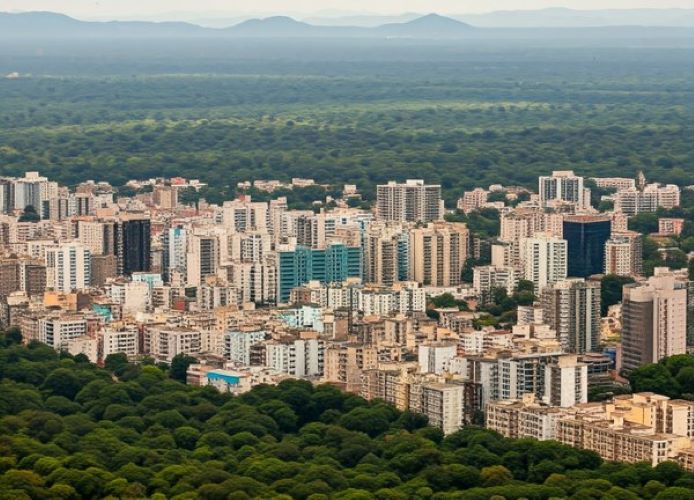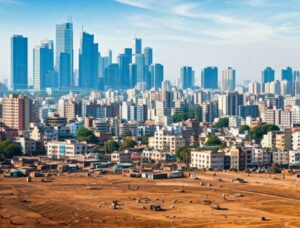Can Nature & Urbanisation Coexist?

Akash Pharande
Before urbanisation took off earnestly in India, humans and nature coexisted admirably. Unfortunately, rampant real estate development has steadily reduced Indians’ access to nature. From the increasing demand for integrated townships with abundant greenery, we can see that urban dwellers today are looking to reconnect with nature.
The Cost of Urbanisation
Our cities’ development agendas have taken a huge toll. Parks and forested regions have been replaced with high-rise skyscrapers. It’s tempting to blame municipal authorities and real estate developers for this loss, but there is no denying that our cities, which have limited space, must adapt to the constantly rising demand for housing, office buildings and the other real estate manifestations of modern-day life.
Supply follows demand, and developers cater to an ever-increasing demand. But there is a price to pay for this demand-supply interplay – nature has been relegated to the sidelines and, in some cities, wiped out altogether. There is a common belief today that greenery has become a luxury that only the rich can afford.
Pune’s Development Trajectory
Let’s take Pune as an example. This city’s geographic limits were previously much narrower, and there was little motivation to expand them. Pune was the quintessential retirement city and was even called Pensioner’s Paradise. Another claim to fame was its educational institutions, earning it the additional tag of ‘Oxford of the East’. The city and its economic activity coexisted amicably with farming activities, even in the core areas.
Going back a little further, the British viewed Pune (then Poona) as a region of political turmoil and resistance to their rule. Pune did not begin to expand geographically or demographically till India gained independence in 1947.
Then the technological revolution in Pune started. It grew from a tiny city to a full-fledged metropolis because of its rapidly expanding employment opportunities, first in manufacturing, then in software technology and information technology-enabled services (ITeS), attracting a massive influx of people.
The city’s population began to rise significantly in the 1990s because of the country’s economic liberalization, which allowed for foreign investment and boosted industrial expansion. Pune’s salubrious climate, along with its robust education infrastructure, began to draw more and more skilled workforce. Infosys and Wipro established bases here, resulting in the creation of the Hinjewadi IT Park.
This resulted in a cascade effect, attracting other tech enterprises and MNCs. Its proximity to Mumbai, India’s financial capital, added to its appeal to firms looking to cut costs. Rapid urbanization resulted in massive infrastructure development, including upgraded road networks, residential complexes, and commercial malls.
As Pune evolved into an IT powerhouse, more and more real estate development was required to accommodate people and the businesses they work in. As of 2024, the estimated population of Pune is 4.44 million within the city limits and 7.35 million in the metropolitan area.
There was minimal impact on Pune’s once-famous natural wealth when it was still relatively small and unspoiled by the rampant urbanization we see today. It is painfully obvious how much of its originally bountiful supply of green open spaces has been depleted by low and high-rise housing constructions, landfills, commercial structures, and shopping malls.
A Steady Disconnect From Nature
This development approach creates a disconnect between city dwellers and the natural environment. The desire to restore a healthy environment and healthier cities is once again staging a resurgence, but most real estate development today revolves around amenities and facilities. The little vegetation available is mostly ornamental.
Our cities are increasingly turning gray rather than green. Any attempts to reconnect people with the environment must be cross-disciplinary and integrated.
A city needs structures, deforestation is inescapable, and buildings will last as long as humanity. But can we restore nature to our cities?
An attempt in Singapore to reintroduce a natural ecosystem into the urban fabric is yielding incredible benefits. What such a vision of urbanisation in the future may accomplish is fascinating. Concrete CAN coexist with a large amount of greenery, and one should not rule out the other.
However, it requires an extremely progressive town-planning vision, strong political resolve, and unwavering backing from the city’s population.
Let’s face it – most of the housing demand in India in recent years is mostly for concrete structures with modern amenities, with a little bit of token vegetation. However, we are seeing a resurgence in demand for nature-rich housing in our cities.
Today’s young homebuyers come from a place of increased environmental conscience, and also concerns about their own and their children’s health and wellness. The rise in demand for homes in integrated townships, which guarantee abundant green, open spaces which will not be violated by further development, is testimony to this fact.
It takes time for a city to lose its ‘green’ reputation; for Bangalore and Pune, it took decades. It will take a few more decades to restore it, but it is achievable if all parties, from town planners and municipal officials to real estate developers and buyers, agree it is worthwhile and must be done.
Akash Pharande is Managing Director, Pharande Spaces,
a leading real estate construction and development firm.


